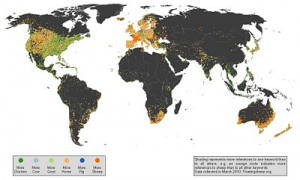From Jacob van Etten.
Some demographic projections tell us that global population numbers will grow to 9 billion in 2100 and stabilize around this number. So how can people three generations down the line feed themselves, while still conserving biodiversity?
Lian Pin Koh offers a solution based on simple economic principles. Grow the most productive crop to produce cereal, oil or protein, and grow each crop where it grows best. He presents an interactive world map to demonstrate that no extra land needs to be taken into production to feed 9 billion people.
The results are interesting. Strikingly, Brazil is doing just fine. Just a bit more of rice and Brazilian agriculture is optimal. Other countries need to change drastically. North European countries need to switch from barley to wheat. Canada and Russia need to abolish wheat agriculture and adopt maize. West Africa and the Cono Sur needs to grow more rice but northern South America and the US need to grow more maize. Yields will go up automagically, as each crop is planted on land that is more suited to it, fulfilling the dream of the 1980s land use evaluators.
The study is still in preparation and no background info on the methodology is available yet. Transport costs and climate change do not seem to be taken into account. “Optimal” seems to refer to yields per hectare, not to labour and inputs. Overall, the trend seems to be towards more high-yielding crops, which also require more inputs. With more people, more labour is available. But other inputs, like water, are limited.
Another question would be why crop use is sub-optimal now. Is it trade barriers? Cultural preferences and agricultural traditions? Or is it economics, really?
There is of course more to conservation than making agriculture more efficient. Another study shows that intensifying land use does not in fact put a break on crop land expansion. Additional measures would be needed to ensure that more efficiency indeed stops crops taking over non-agricultural land, and impacting biodiversity.
Even so, this is an interesting thought experiment. In an ideal world, swapping crops is enough to raise crop production some 30%. Feeding 9 billion people suddenly appears a bit easier.
